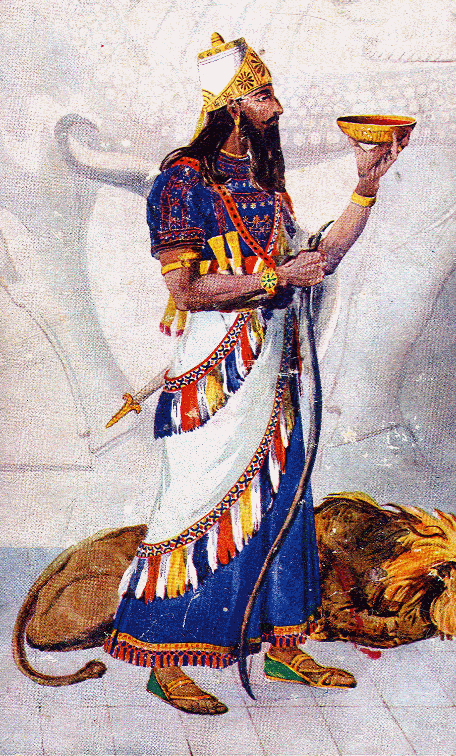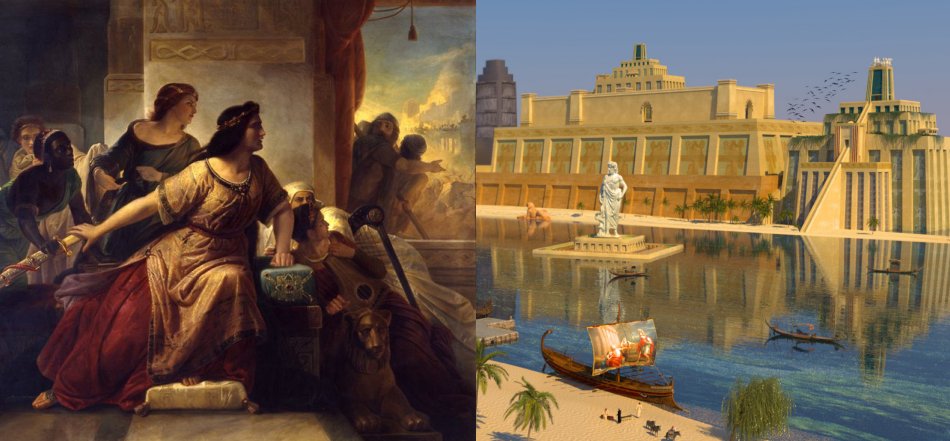
by
Damien F. Mackey
“How you have fallen from heaven, morning star, son of the dawn!
You have been cast down to the earth, you who once laid low the nations!”
You have been cast down to the earth, you who once laid low the nations!”
Isaiah 14:12
Commenting on his recent finding of my article:
Sargon II and Sennacherib, More Than Just and Overlap
a reader has written to me:
Damien,
I was studying this past week for a sermon on Isaiah 14, and trying to determine, "Who is the King of Babylon?" Nebuchanezzar, Nabonidus, and Belshazzar did not seem to be compatible with the details. I discovered that Sennacherib and Sargon II have been proposed by some.
That was interesting. I read up on them online and discovered that Sennacherib, Esarhaddon, and Ashurbanipal (I think) claimed the title "King of Babylon". That was really interesting.
I discovered that Sargon II was a great conqueror, and thought that fit with the image of an oppressor who had put down a lot of kings, who would be quite excited to see him thrust down to Sheol. I discovered that his death sounded a lot like Isaiah 14:19, in which a corpse does not find a grave and is not joined in burial with the other kings.
However, the declarations of verse 13, in which the king exults himself against God, intends to be higher than God, and intends to scale the mount of the congregation (the temple mount in Jerusalem) sounded a lot more like Sennacherib who blasphemed God in a manner much like that, and intended to conquer the city of Jerusalem. I was quite puzzled. Was the king of Babylon Sargon II or Sennacherib? Then I found your writing, "Sargon II and Sennacherib, More Than Just and Overlap." That was quite a moment!
Thanks for that writing. It was really helpful. Would you consider adding the suggestion to Wikipedia that Sargon II and Sennacherib could be the same person? It would be nice to rescue Assyrian chronology from being entirely dominated by secular influence.
Seeing the King of Babylon as the Assyrian king of Babylon really helps make sense of Isaiah 14:25, where God says that he will break the Assyrian in "my land". If Sennacherib is in view in the passage, this verse referring to the death of the 185,000 soldiers is entirely in context, and not just oddly inserted.
I also discovered that James Ussher in Annals of the World, p. 82, said, "Sargon is also called Sennacherib." Do you know why scholars rejected this understanding, if it was current in Ussher's day?
How do you harmonize the suggestions that Sargon was killed in battle, and his body never found, with the story of Sennacherib killed in a temple by his sons? Are there other details that are difficult to fit into your theory?
Once again, Thanks so much! God bless your studies. ….
Damien Mackey’s response to this terrific e-mail:
A big part of the problem that has led to a wrong arrangement of ancient kings and dynasties is - as Dr. Immanuel Velikovsky had pointed out in his Theses and in his various books - the artificial over-extension of Egyptian chronology that has largely been used as the measuring rod for other nations, such as Assyria and Babylonia, thereby throwing these right out of whack.
See e.g. my article on this:
The Fall of the Sothic Theory: Egyptian Chronology Revisited
So even though some of the early, say, biblical historians, such as Ussher (and thank you for pointing this out) may rightly have discerned that, as you quote: "Sargon is also called Sennacherib", later biblical historians, tying themselves to a faultily constructed Assyrian chronology, are forced then to mangle the biblical record in order to ‘make it fit’ the wrongly construed secular one.
What a mess!
The much lauded Edwin Thiele, for instance, has completely ruined the chronology of the Judean king Hezekiah by making it fit with what he imagines to be a virtually rock-solid neo-Assyrian chronology. (Thiele’s Mysterious Numbers of the Hebrew Kings)
A pity that the likes of Thiele did not pay attention to an ancient source like the Book of Tobit, which has “Sennacherib” directly succeeding his father, “Shalmaneser” (Tobit 1:15). No mention whatsoever there of Sargon – not because he did not exist, but because, well we know why, Sargon was Sennacherib. Isaiah 20:1 mentions “Sargon”, the only known reference to this great king down through the centuries until his city of Dur-Sharrukin (“Fortress of Sargon”) was discovered at the site of Khorsabad in the C19th AD.
“In time, the ruins were buried by the sands and the city was forgotten. The settlement known as Khorsabad came to be established on the spot, and then, in 1873 CE the archaeologist Paul Emile Botta began excavations there. These were later carried on by another archaeologist named Victor Place”. https://www.ancient.eu/Dur-Sharrukin/
In my university thesis:
A Revised History of the Era of King Hezekiah of Judah
and its Background
and its Background
I had written regarding the earlier puzzlement about Sargon (Volume One, pp. 134-135):
Sargon was for many centuries a complete mystery as Boutflower has explained,[1] with reference to Isaiah’s verse 20:1, which Boutflower gives as: “The year that the Tartan [Turtan] came to Ashdod, when Sargon king of Assyria sent him”:
... Sargon, the founder of the last and greatest dynasty of Assyria’s warrior kings. Of the dynasty which he founded Sargon was the ablest monarch: indeed he is regarded by some as the greatest of all Assyrian kings .... For long ages the only mention of this great king was found in the opening verse of Isa. xx, which heads this chapter. Accordingly, the older Biblical commentators were much puzzled as to who Sargon could be. Was he Sennacherib? or Shalmaneser? or a successor of Shalmaneser and immediate predecessor of Sennacherib?
The early archaeological efforts of the mid-C19th solved the problem, so Boutflower thought:
The mystery was at length solved when the first Assyrian palace, brought to light by the excavations of Botta at Khorsabad in 1842, proved to be the palace of Sargon, erected by him in his new city of Dur-Sargon: and it was presently seen that the last guess was the right one.
Indeed there are several very strong indicators, at least on the surface of things, as to why one should adhere to the textbook view, as summed up by Boutflower, that Sargon was “a successor of Shalmaneser and immediate predecessor of Sennacherib”.
[End of quotes]
How to reconcile supposed separate (different types of) deaths of Sargon II, of Sennacherib?
On p, 137 of my university thesis I told of a mischievous insertion by Winckler and Delitzsch of the name “Sargon” into the Assyrian texts:
Another seemingly compelling evidence in favour of the conventional chronology, but one that has required heavy restoration work by the Assyriologists, is in regard to Sennacherib’s supposed accession. According to the usual interpretation of the eponym for Nashur(a)-bel, (705 BC, conventional dating), known as Eponym Cb6, Sargon was killed and Sennacherib then sat on the throne:[2]
The king [against Tabal....] against Ešpai the Kulummaean. [......] The king was killed. The camp of the king of Assyria [was taken......]. On the 12th of Abu, Sennacherib, son [of Sargon, took his seat on the throne].
Tadmor informs us about this passage that: “Winckler and Delitzsch restored: [MU 16 Šarru-ki]n; ana Ta-ba-lu [illik]”. That is, these scholars took the liberty of adding Sargon’s name.
Jonsson, who note has included Sargon’s name in his version of the text, gives it more heavily bracketted than had Tadmor:[3] “[Year 17] Sargon [went] against Tabal [was killed in the war. On the 12th of Abu, Sennacherib, son of Sargon, sat on the throne]”.
This document will become hugely significant in the context of this thesis.
[End of quotes]
To cut to the chase, the ill-fated “Assyrian” who died in the land of Israel just prior to the rout and devastation of king Sennacherib’s 185,000-strong army, was Sennacherib’s eldest son, Ashur-nadin-shumi, the devious “Nadin” (Nadab) of the Book of Tobit, the world-conquering commander-in-chief “Holofernes” of the Book of Judith, according to my reconstructions, e. g:
"Nadin" (Nadab) of Tobit is the "Holofernes" of Judith
Oh, yes, and this Ashur-nadin-shuni was indeed a king of Babylon:
As crown prince of Assyria, Ashur-nadin-shumi was installed by his father as King of Babylon about 699 BC. In 694 BC when Sennacherib attacked southern Elam in pursuit of Chaldaean rebels, the Elamites attacked Babylon. Ashur-nadin-shumi was captured and taken to Elam, where [sic] he was probably killed.[1]
He was in fact slain by the Simeonite heroine, Judith, near Shechem (“Bethulia”).




